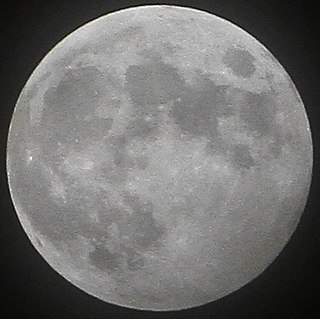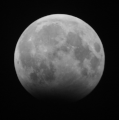
A partial lunar eclipse took place on 16 August 2008, the second of two lunar eclipses in 2008, with the first being a total eclipse on 20 February 2008. The next lunar eclipse was a penumbral eclipse occurring on 9 February 2009, while the next total lunar eclipse occurred on 21 December 2010.

A total lunar eclipse occurred from 5:27 to 11:06 UTC on 21 December 2010, coinciding with the date of the Winter solstice in the Northern Hemisphere and Summer solstice in the Southern Hemisphere. It was visible in its entirety as a total lunar eclipse in North and South America, Iceland, Ireland, Britain and northern Scandinavia.

A total lunar eclipse took place on 10 December 2011. It was the second of two total lunar eclipses in 2011, the first having occurred on June 15. A lunar eclipse occurs when the Moon is positioned just right in its orbit to pass through Earth's shadow.

A penumbral lunar eclipse took place on 7 July 2009, the second of four lunar eclipses in 2009. This eclipse entered only the southernmost tip of the penumbral shadow and thus was predicted to be very difficult to observe visually. This lunar eclipse was the predecessor of the solar eclipse of 22 July 2009.

A penumbral lunar eclipse took place on 6 August 2009, the third of four lunar eclipses in 2009. The Moon's small entry into the Earth's penumbral shadow produced an extremely subtle dimming of the Moon's southern edge, difficult to observe visually.

A partial lunar eclipse occurred on 26 June 2010, the first of two lunar eclipses in 2010. At maximum eclipse, 53.68% of the Moon was covered by the Earth's shadow.

A partial lunar eclipse took place on 4 June 2012. It was the first of two lunar eclipses occurring in 2012, the second eclipse set to happen on 28 November. The Moon was about 37% covered by the Earth's northern umbral shadow at maximum eclipse.

A penumbral lunar eclipse occurred on 28 November 2012, the second of two lunar eclipses in 2012.

A partial lunar eclipse took place on 25 April 2013, the first of three lunar eclipses in 2013. Only a tiny sliver (1.48%) of the Moon was covered by the Earth's umbral shadow at maximum eclipse, but the entire northern half of the Moon was darkened from being inside the penumbral shadow. This was one of the shortest partial eclipses of the Moon for the 21st century, lasting 27 minutes. This was the last of 58 umbral lunar eclipses of Lunar Saros 112.

A penumbral lunar eclipse took place on 18–19 October 2013, the last of three lunar eclipses in 2013.

A total lunar eclipse took place on Wednesday 8 October 2014. It is the second of two total lunar eclipses in 2014, and the second in a tetrad. Other eclipses in the tetrad are those of 15 April 2014, 4 April 2015, and 28 September 2015. Occurring only 2.1 days after perigee, the Moon's apparent diameter was larger, 1960.6 arcseconds.

A total lunar eclipse took place on 4 April 2015. It is the former of two total lunar eclipses in 2015, and the third in a tetrad. Other eclipses in the tetrad are those of 15 April 2014, 8 October 2014, and 28 September 2015.

A total lunar eclipse took place between 27 and 28 September 2015. It was seen on Sunday evening, 27 September, in the Americas; while in Europe, Africa, and the Middle East, it was seen in the early hours of Monday morning, 28 September. It was the latter of two total lunar eclipses in 2015, and the final in a tetrad. Other eclipses in the tetrad are those of 15 April 2014, 8 October 2014, and 4 April 2015.
A penumbral lunar eclipse took place on 23 March 2016, the first of three lunar eclipses in 2016. The Moon was just 2.1 days before apogee, making it very small, so this was a "Micromoon" penumbral lunar eclipse.

A penumbral lunar eclipse took place on 16 September 2016, the last of three lunar eclipses in 2016.

A partial lunar eclipse took place at the Moon's descending node on the evening of 7 August and the morning pre-dawn on 8 August 2017, the second of two lunar eclipses in 2017. The Moon was only slightly covered by the Earth's umbral shadow at maximum eclipse. The Moon's apparent diameter was smaller because the eclipse occurred only 5 days after apogee.
A penumbral lunar eclipse took place on Tuesday, January 20, 1981, the first of two lunar eclipses in 1981. In a rare total penumbral eclipse, the entire Moon was partially shaded by the Earth, and the shading across the Moon should have been quite visible at maximum eclipse. The penumbral phase lasted for 4 hours and 24 minutes in all, though for most of it, the eclipse was extremely difficult or impossible to see. The moon's apparent diameter was larger because the eclipse occurred 5.2 days after perigee.

A partial lunar eclipse occurred on 19 November 2021. The eclipse occurred towards a micromoon. This was the longest partial lunar eclipse since 18 February 1440, and the longest until 8 February, 2669; however, many eclipses, including the November 2022 lunar eclipse, have a longer period of umbral contact at next to 3 hours 40 minutes. It was often referred to as a "Beaver Blood Moon" although not technically fulfilling the criteria for a true blood moon (totality).

A penumbral lunar eclipse took place on 30 November 2020. A penumbral lunar eclipse occurs at full moon when the Moon passes through Earth's penumbral shadow.

A total lunar eclipse took place on Monday, April 24, 1967, the first of two total lunar eclipses in 1967, the second being on October 18, 1967.
































































